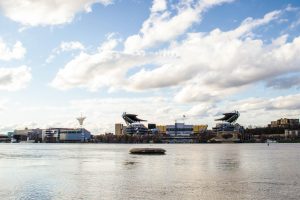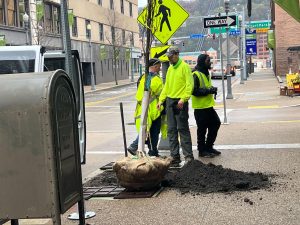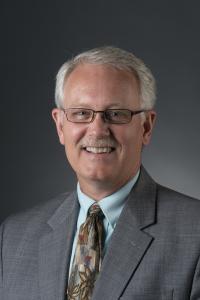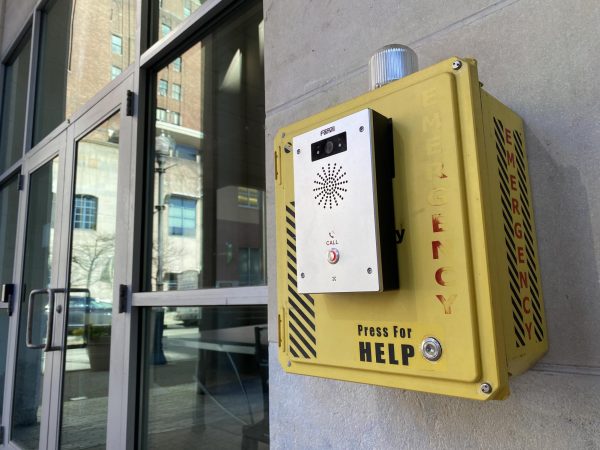University holds roundtable discussion on technology
December 5, 2022
In Lawrence Hall 200 on November 17, students had the opportunity to question how technology was harming the environment and how it could be used to combat the problems it creates around Point Park and the world. Honors student Jandi Linde ran the roundtable discussion between three Point Park analysts and a student audience.
Assistant vice president of information technology, Dr. Tim Wilson, described technology as a double-edged sword. He explained that through its evolution, technology has both helped the world and harmed it.
“An admissions process 10 years ago was very paper driven,” Wilson said. “People applied to the university using paper, they used a pen, they sent it in the mail, the mail carrier had to move a truck from A to B, right? Today, the vast majority of applications that come into the university, we direct them to do online applications, there’s a digital footprint that happens from the time that you apply to the university to the time that you get accepted. None of the footprint has to do with paper anymore.”
Through its evolution, Wilson related the increase in use of technology to the ability to cause a benefit in the environment as well as leaving negative effects on it. Dr. Heather Fiedler, department chair and professor of community engagement and leadership at Point Park also recognizes the negative effects that technology can have on the environment.
“When we think about how technology has impacted the environment and how it can help the environment,” Fiedler said. “I think about things like greenhouse gas emissions and how they’re really hurting our food supply, and how if it doesn’t stop, our supply of vegetables will decrease continuously. There’s a prediction that they could decrease as much as 35 percent in the coming years.”
Fielder then recognized that although technology can have those negative effects it can also be used as a tool to combat some of those problems to help heal the environment, “we’re seeing things like new ways to grow rice that will help it sustain even when it’s flooding. So, there are a lot of really wonderful technologies on the horizon, things like drones to look at forest fires and forest sustainability, and to catch poachers.”
Fidler also urges students to be advocates and the change in less than environmentally conscious problems that take place. She discusses an area of need that is within the persuasion and control of a student advocate.
“I’m going at this from an angle of how we can use technology to help, as opposed to the impact that technology is having because I don’t personally work in tech,” said Fidler, “but I think there is a lot of work that can be done for advocacy here on campus and that is where I think you all can really come in. So, we know that a lot of college campuses are thinking about how they can become more green and more environmentally conscious, by putting things in like water bottle refilling stations. That is a matter of students pushing for things like that.”
Associate professor of physics, Dr. Brendan Mullen, spoke about statistics of energy and raw materials.
“In one google search, that requires about 1000 Joules of energy, as we say in physics, which is about the equivalent of running one low power light bulb for about an hour. The range is tough to explain,” Mullen said. “It’s not something that you’ve probably thought about before. A surprising amount of energy goes into the simplest actions like the internet.”
Mullen also explains how that use of energy correlates to what our economy can sustain when it comes to energy usage.
“Since about the 1600s we’ve experienced a growth rate in our energies to about 2.5-3% percent per year,” Mullen said. “It doesn’t sound like much, but that’s actually an exponential growth rate. Compare that to what’s considered a good growth rate for our economy and you can see that energy use is outstripping our economic growth rate.”
He also discussed the world’s current energy use on a visual scale and how much larger of a scale that might look like in the future.
“It’s like if you were to put down 60-watt light bulbs and put them on the ground and put them all together, right now we’re using an amount of energy equivalent to covering Rhoad island in light bulbs,” Mullen said. “But if you continue our trend in the future, by the 20 third century or so, we’ll need about the size of Alaska to represent our energy use. And that many lightbulbs in Alaska, is like a heat lamp the size of Alaska, and that’s why our planet will heat up by that much- which is actually exceeding the tolerance limit of human beings.”
The questions asked at the roundtable were spearheaded by the honors city and university life students.













